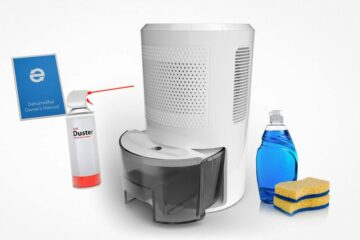When watching the weather channel or checking for updates on your favorite weather site, you might notice them listing humidity or dew-point averages, along with temperature and precipitation. You may understand temperature and precipitation but what about humidity and dew point? Here’s some info to help make understanding humidity and dew point easier.
Understanding Humidity
We are all familiar with that muggy and sticky feeling we get in a humid environment. Humidity is the moisture in the air, and it can drastically change how the environment feels and it even affects how we perceive the temperature! A lot of these effects are negative and change indoor air quality for the worse.
Water evaporates the warmer it gets, warmer environments produce far more moisture than colder environments. This also means a change in humidity during changes in seasons, with summer months producing more moisture over winter months. Humidity is also affected by an area’s distance from bodies of water such as lakes, rivers, and oceans. Though there isn’t much we can do with the humidity outside, there are ways to prevent it from affecting you inside your home or living place.
Humidity is commonly measured in relative humidity and people tend to comfortably live in environments with a relative humidity of 45 to 55%—this level of relative humidity will allow you to maintain a healthy environment both for your body and living space.
But what about the dew point?
Understanding the Dew Point
Whenever you see a meteorologist on the screen they are usually bringing up dew point in reference to humidity. The dew point is the temperature at which the air becomes saturated with moisture, causing dew droplets to form. You can see the phenomenon on a cool glass of water with water droplets streaming down its sides—a result of the cool water in the cup bringing down the temperature of the air around it and condensing the water in the air. As a general rule, the closer the dew point is to the actual temperature, the higher the humidity level and the more uncomfortable it will feel.
When you are watching the meteorologist on the local news or on your favorite weather app, you’ll see that dew point is one of the key parts of a weather report. The dew point gives you a relatively good idea of how it is going to feel outside but also how it might feel inside your house. And this humidity might end up leaking into your home. Here is a chart that might help you figure out how dew point levels will feel on a comfortability basis:
- Dew points below 55 are very comfortable for most people
- 56 ” 60 “Still pretty comfortable
- 61 ” 65 “Starting to get “sticky’
- 66 ” 70 “Starting to feel “muggy” now, and quite uncomfortable
- 71 ” 75 “Oppressive
- 76+ “‘Let’s just call it Miserable
Though calculating the dew point is difficult indoors, you can tell when your household has hit that dew point temperature when you see condensation on your windows. Having water stream down your windows is destructive to your household and even more importantly, it is destructive to your health.

Dew Point and Health
Having humidity at about 45-55% is comfortable for most people, but it is also a healthy environment to be in. Keeping the humidity down helps improve the indoor air quality in your home, as well as keep your family more comfortable.
Say Goodbye to Humidity with Eva-Dry
Luckily you are not powerless when it comes to controlling the humidity within your home. You can control the indoor humidity with the use of air conditioning or dehumidifiers – depending on where you live, a combination of the two might be necessary. You can measure the relative humidity in your home using a hygrometer.
For smaller spaces, check out the Eva-Dry petite electric dehumidifiers; the Eva-Dry 1100, the Eva-Dry 1200, and the Eva-Dry 2400. These units are good up to 1100 cubic feet, 1200 cubic feet, and 2400 cubic feet, respectively.
For larger spaces, invest in the Eva-Dry 4000. This unit will help keep your basement or main living area, up to 4000 cubic feet, at a comfortable relative humidity of 45-55% year-round. The unit uses state-of-the-art Rotary Desiccant Technology to remove water from the air. Safer and less noisy than traditional compressor dehumidifiers, it features a large capacity catch basin and a built-in ionizer and filter.
Eva-Dry is on the leading edge of dehumidification technology and understands how important it is to maintain good indoor air quality to support health and keep your family comfortable. Investigate their full line of products and contact one of their knowledgeable consultants today about the humidity, condensation, and mold or mildew issues you may be experiencing.




